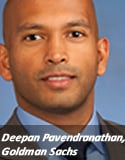Goldman Sachs’ newly-launched Sigma X dark liquidity pool in Australia has seen a reduction in market impact costs by up to 30%, with estimated cost savings rising above 40% for small and mid-cap names, says Deepan Pavendranathan, the firm’s head of advanced trading services in Australia.
Officially launched 12 March, Sigma X connects a broad range of liquidity participants from offshore and domestic sources, including institutional long-only investors, long-short funds and liquidity sources from the group’s global equity-linked business. Sigma X permits trading in all stocks listed on the Australian Securities Exchange (ASX).
Australia is the second market in Asia Pacific – after Japan – where Goldman Sachs has launched Sigma X, and the firm plans to expand the crossing capabilities to other markets.
“Sigma X has been up and running for some time in the US where its been hugely successful. We leveraged off the technology and customised it for the Australian market. Our clients are seeing real benefits in terms of better execution through the use of Sigma X,” Pavendranathan said.
Fragmentation delivers
The importance of taking full advantage of pools of non-displayed liquidity is underscored by the continued fragmentation of the Australian market and the growth in low latency trading activity globally. Pavendranathan expects participation in alternative liquidity pools to continue growing as investors strive to be more cost effective while minimising signaling risk.
Goldman Sachs research has found the execution quality of the firm’s VWAP algorithm improves with increased crossing – the firm estimates a 10% reduction in execution shortfall given a 25-30% average crossing rate. A possible 30%-plus reduction in market impact is generated by the significant savings generated by crossing at the mid-quote, as well as faster execution with less information leakage.
“Our sample of clients’ orders had an average alpha of around seven basis points (65% of the average shortfall). As crossing engines allow for faster completion with no disclosure of orders pre-trade, they enable greater capture of short-term alpha and limit adverse price moves due to information leakage,” said Goldman Sachs analyst Matthew Ross in a research report.
“We had a particularly large trade a few weeks ago where we saw crossing rates north of 40% for the whole trade,” said Pavendranathan. “In general, it’s not unusual for clients to get crossing rates of about 20%.”
Notwithstanding the changing regulatory environment in Australia, the ultimate goal of Sigma X is to get better execution for its clients, said Pavendranathan.
Responding to need
Respondents to the Australian Securities and Investment Commission’s (ASIC) second-phase consultation paper on equity market structure (CP-168) are divided on the issue of dark pool liquidity and transparency. ASIC has proposed replacement of the current definition of a block order at A$1 million with a more flexible regime governed by liquidity levels. The regulator has also suggested a A$50,000 threshold be imposed on dark trades arising from limit orders if dark liquidity below block size grows by 50% in the next three years.
Ross’ research report pointed out that achieving best execution requires more than just sophisticated algorithms. First-generation algorithms relied only on the ASX for liquidity and as such the most sophisticated programs had the greatest edge. While the speed and complexity of execution systems remains crucial to their success, the advent of crossing engines places a significant focus on both the breadth and depth of volumes that can be accessed. The ability to cross orders in a large and diverse pool of non-displayed liquidity appears critical to being able to generate best execution outcomes, the report noted.
The extent to which an order is crossed has a very significant impact on the execution shortfall. Crossing 100% of an order reduces the average execution cost by 3.6bp or approximately 33% of a similar order that achieves no crosses. Over the period, the firm’s VWAP engine crossed an average of 20% of its sample of orders (~30% in ASX 20 names, 10-15% in ex-ASX 50 names). If orders where no stock was crossed were excluded, the average crossing rate was closer to 45%.
